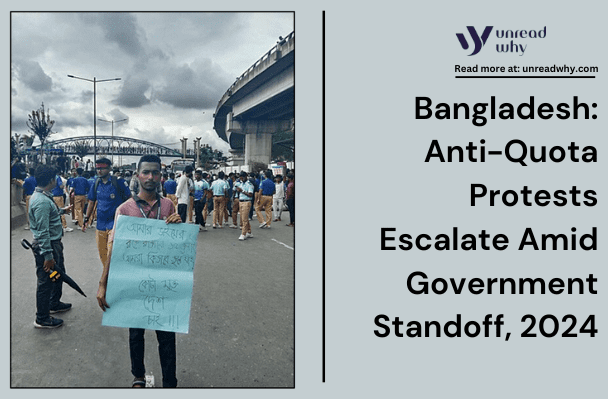Bangladesh is in turmoil as thousands of students demand an end to job quotas in unprecedented nationwide protests.
July 2024, Bangladesh has seen a resurgence of widespread protest by students against the government’s reinforcement of job quotas. These protests, which began earlier, have gained momentum and drawn thousands of students from universities and colleges across the country. The protests began after the High Court announced the government to reinstate the job quotas for descendants of freedom fighters.
Since when did Bangladeshi students demand reforms in the job quota system?
Let’s understand the overall drawbacks happening in Bangladesh. The quota system in Bangladesh was introduced in 1972, and it reserves significant portions of government jobs for specific groups, including ethnic minorities, descendants from freedom fighters by 30 per cent (people fought in the 1975 Liberation War) and women. The population of the country have called for reforms, with major student movements pushing for merit-based recruitment since the early 2010s. In 2018, there were backlashes against the system, as students said it was unfair and demanded its abolition. In 2020, it was abolished, but in this month (July) it brought again, leading to all the chaos happening right now.
What is the demand of the protesters?
The primary demand of the students is the abolition of the current quota system in government jobs, where they argue that the conventional job system in Bangladesh is discriminatory and favours certain groups at the expense of merit-based hiring. The quota system, since its inception allocates a significant portion of the government jobs.
The unrest in the country intensified on July 15, 2024, after Prime Minister Sheikh Hasina, in a press conference, refused to meet the demands of the students; rather, she offered her hand for negotiation, and she stated that the matter was now before the court. The protesters compared her comments to the Razakar Force – collaborators with the Pakistani army during the 1971 War of Independence. As a consequence, it led to midnight protests across numerous campuses in Bangladesh, where students tuning on flashlights of their phones and banging utensils in a dramatic display of dissent.
The current wave of protests
The situation has been marked by large gatherings and blockades at key intersections and highways. In the context of Dhaka (the capital city), students are noticed to block major roads and intersections, including Shahbagh, Minto Road, and Banglamotor. This disrupted the local public’s daily commitments. A similar case was seen in cities, including Cumila, Sylhet, Barishal, Rajshahi as well as Chittagong. The protests are laid by creative forms, where students are seen singing patriotic songs, and chanting anti-quota slogans. Despite police barricades, the situation remained peaceful, although there have been sporadic clashes with members of the Bangladesh Chhatra League, which is the student ring of the ruling Awami League.
What responses are made by the government of Bangladesh?
Sheikh Hasina, the Prime Minister, has warned that while peaceful protests will be tolerated, any violence will be met with strict action. Despite such responses, students under the banner of the Students Movement Against Discrimination have submitted a memorandum to President Mohammad Shahabuddin, where they have requested an emergency parliamentary session so that they can consider their demands.
The students insisted on the formation of a commission in order to reform the quota system and argued that recruitment should be primarily merit-based with limited quotas for marginalized groups. Although there are several things happening in between, the protests led by the students represent a challenge to the Prime Minister’s government, where she is facing criticism for the way the situation is being handled as it marks one of the first-ever massive demonstrations against her administration since it began its fourth consecutive terms of quandary 2024.
Is the situation getting worse?
As of July 19, 2024, the condition is escalating worse in the nation. There were armer vehicles on the streets of Dhaka, and riot cops arrived, using tear gas and rubber bullets to repel protesting students. The death of students led by the protests is nearly 39, and around 500 are injured. The death tour keeps rising. Where the news of 6 protesters came in the morning of July 18, and 19 individuals died in the evening. The situation in Bangladesh is spiralling out of control. Prime Minister Sheikh Hasina shared her condolences for the demises in the country. She condemned her words for the lost lives, trying to improve the situation.
Is this the only protest Bangladesh has ever faced?
This is not the first, worst condition, since public protest is a recurring aspect in Bangladesh. Consider the list of protests that happened in the streets of Bangladesh –
| Years | Protests |
| 2010 | Protests by Garment workers |
| 2013 | The Rana Plaza Protest, where a factory collapsed and killed innocent people, led to public protests. |
| 2013 | Shahbagh Protest, thousands of people demanded the death penalty for a convicted war criminal. |
| 2018 | Protested by Bangladeshis for road safety. |
| 2018 | Again, protested against the 30% reserve seats for descendants of the freedom fighters. |
| 2020 | A massive movement was organized by the opposition to unseat Sheikh Hasina. |


